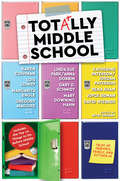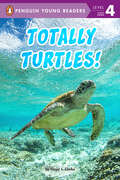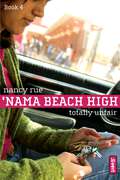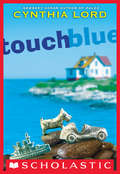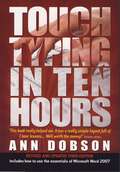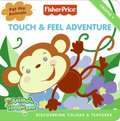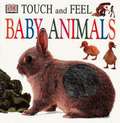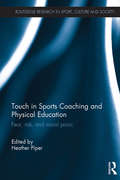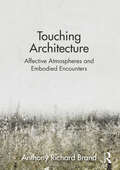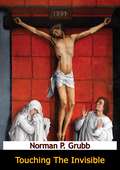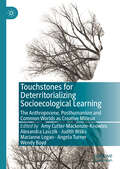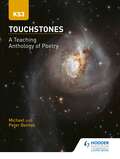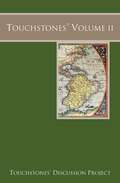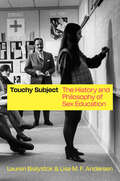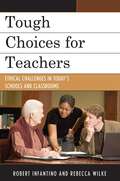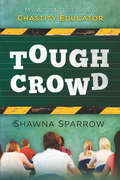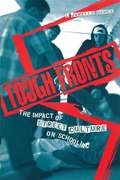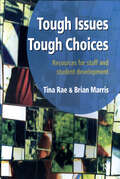- Table View
- List View
Totally Middle School: Tales of Friends, Family, and Fitting In
by Betsy GrobanFrom literary masterminds Lois Lowry, Gary D. Schmidt, Linda Sue Park, Katherine Paterson, Karen Cushman, Gregory Maguire, and more comes a timeless and inspirational anthology about the sometimes-challenging, always-rewarding coming-of-age years: middle school.With eleven short stories told in text messages, emails, formal letters, stories in verse, and even a mini graphic novel, Totally Middle School tackles a range of important subjects, from peer pressure, family issues, and cultural barriers to the unexpected saving grace of music, art, friendship, and reading. Brimming with heart and humor, these poignant stories from bestselling and award-winning authors shine a light on the moments when everything is thrilling and terrifying at the same time--in a way it will never be again.
Totally Turtles! (Penguin Young Readers, Level 4)
by Ginjer L. ClarkeLearn about turtles and their many talents in this nonfiction leveled reader perfect for kids interested in these shelled creatures and their lives on land and in the water!Did you know that leatherback turtles can weigh up to two thousand pounds? Or that the Florida softshell turtle can breathe through its snout and its skin? Turtles have been around for millions of years and we&’re still learning more about them! With simple language and vivid photographs, Totally Turtles! is perfect for emerging readers curious about turtles and how they have managed to adapt, survive, and thrive for so long.
Totally Unfair ('Nama Beach High)
by Nancy RueLaura Duffy has been through some tough stuff--moving to a new state, starting her junior year in a new school, fights, kidnapping attempts, accusations, even explosions; but she's always had her friends to fall back on--at least until now.
Touch Blue
by Cynthia LordAn exquisite second novel from the Newbery Honor author of RULES! TOUCH BLUE, sure as certain, will touch your heart.The state of Maine plans to shut down her island's schoolhouse, which would force Tess's family to move to the mainland--and Tess to leave the only home she has ever known. Fortunately, the islanders have a plan too: increase the numbers of students by having several families take in foster children. So now Tess and her family are taking a chance on Aaron, a thirteen-year-old trumpet player who has been bounced from home to home. And Tess needs a plan of her own--and all the luck she can muster. Will Tess's wish come true or will her luck run out?Newbery Honor author Cynthia Lord offers a warm-hearted, humorous, and thoughtful look at what it means to belong--and how lucky we feel when we do. Touch Blue, sure as certain, will touch your heart.
Touch Typing In Ten Hours
by Ann DobsonFeaturing an easy-to-learn method to touch type, this edition includes how to use Microsoft Word 2007 to best advantage.
Touch Typing In Ten Hours: Spend A Few Hours Now And Gain A Valuable Skill For Life
by Ann DobsonFeaturing an easy-to-learn method to touch type, this edition includes how to use Microsoft Word 2007 to best advantage.
Touch and Feel Adventure: Discovering Colors and Textures (Fisher-Price: Animals of the Rainforest)
by Alexis BaradBABY WILL LOVE DISCOVERING THE RAINFOREST BY TOUCHING REALISTIC TEXTURES. You can point out colors, too, as you introduce Baby to different furry, bumpy, and fuzzy animal friends.
Touch and Feel Baby Animals
by DkCome inside and discover the different textures of adorable baby animals.
Touch in Sports Coaching and Physical Education: Fear, Risk and Moral Panic (Routledge Research in Sport, Culture and Society)
by Heather PiperIn our increasingly risk-averse society, touch and touching behaviours between professionals and children have become a fraught issue. In sports coaching and physical education, touching young sports performers and participants has, in some contexts, come to be redefined as dubious and dangerous. Coaches find themselves operating in a framework of regulations and guidelines that create anxiety, for them and others, and for many volunteer (and sometimes professional) coaches, this fearful context has led them to question the risks and benefits of their continuing involvement in sport. Touch in Sports Coaching and Physical Education is the first book to explore this difficult topic in detail. Drawing on a series of international studies from the US, UK, Australia, Canada, Sweden and elsewhere, it presents important new research evidence and examines theories of risk and moral panic that frame the discussion. By challenging prevailing orthodoxies the book makes a significant contribution to critical discussion around practice, pedagogy, politics and policy in sport and physical education, and also informs current debates around the nature and quality of all in loco parentis relationships.
Touching Architecture: Affective Atmospheres and Embodied Encounters
by Anthony BrandThis book is about perception, emotion, and affect in architecture: how and why we feel the way that we do and the ways in which our surroundings and bodies contribute to this. Our experience of architecture is an embodied one, with all our senses acting in concert as we move through time and space. The book picks up where much of the critique of architectural aestheticism at the end of the twentieth century left off: illustrating the limitations and potential consequences of attending to architecture as the visually biased practice which has steadily become the status quo within both industry and education. It draws upon interdisciplinary research to elucidate the reasons why this is counter-productive to the creation of meaningful places and to articulate the embodied richness of our touching encounters. A "felt-phenomenology" is introduced as a more-than visual alternative capable of sustaining our physical, emotional, and psychological well-being. By recognising the reciprocal and participatory relationship that exists between atmospheric affect and our (phenomenological) bodies, we begin to appreciate the manifold ways in which we touch, and are touched, by our built environment. As such, Touching Architecture will appeal to those with an interest in architectural history and theory as well as those interested in the topic of atmospheres, affect, and embodied perception.
Touching the Invisible
by Norman P. GrubbHow can I have Christ's power in my everyday life?Until we know how to recognize God's voice, we are unsure of His will, uncertain in our prayers, and ineffective in our Christian service. Norman Grubb opens the reality of living secretly with God, whose invisible resources become more real than the visible world around us. The answers here have revolutionized the lives of thousands, providing practical help for those who desire a life of power; the heritage of all who are "hidden with Christ in God."
Touchstones for Deterritorializing Socioecological Learning: The Anthropocene, Posthumanism and Common Worlds as Creative Milieux
by Wendy Boyd Angela Turner Amy Cutter-Mackenzie-Knowles Alexandra Lasczik Judith Wilks Marianne LoganThis book focuses on socioecological learning through the touchstone concepts of the Anthropocene, the Posthuman and Common Worlds as Creative Milieux. The editors and contributors explore, situate and interrogate social learning through transdisciplinary positionings, exemplars and theories. The eclectic and cohesive chapters unfold as a journey that may inspire innovative and unique understandings of the socioecological learner: insights that will surely be paramount as we careen towards the 22nd century and all of its as-yet-unknown challenges. Offering tangible and nuanced practice for educational leadership in socioecological learning, this pioneering book will be of interest and value to researchers and educators at all levels. This volume is sure to appeal to students and scholars of socioecological learning as well as the Anthropocene and the Posthuman.
Touchstones: A Teaching Anthology of Poetry
by Michael Benton Peter BentonDevelop a love for poetry at key stage three with the trusted Touchstones series. This diverse selection of over 150 poems features thought-provoking contemporary voices and much-loved favourites. Touchstones: A Teaching Anthology of Poetry will help you to:· Explain and contextualise poems across a broad range of genres and themes· Support your lessons with over 100 ready-made activities designed for independent, paired and group work· Challenge your students with additional activities specifically designed to stretch their learning· Build the skills required for the poetry element of the latest GCSE English Literature specifications, with chapters dedicated to comparative and unseen poetry· Introduce a range of poets commonly studied at GCSE, from William Wordsworth to Imtiaz Dharker· Introduce a range of contemporary poets, such as Kate Clanchy and Holly McNish, alongside more familiar classics· Support the implementation of the 2014 national curriculum at Key Stage 3
Touchstones: A Teaching Anthology of Poetry
by Michael Benton Peter BentonDevelop a love for poetry at key stage three with the trusted Touchstones series. This diverse selection of over 150 poems features thought-provoking contemporary voices and much-loved favourites. Touchstones: A Teaching Anthology of Poetry will help you to:· Explain and contextualise poems across a broad range of genres and themes· Support your lessons with over 100 ready-made activities designed for independent, paired and group work· Challenge your students with additional activities specifically designed to stretch their learning· Build the skills required for the poetry element of the latest GCSE English Literature specifications, with chapters dedicated to comparative and unseen poetry· Introduce a range of poets commonly studied at GCSE, from William Wordsworth to Imtiaz Dharker· Introduce a range of contemporary poets, such as Kate Clanchy and Holly McNish, alongside more familiar classics· Support the implementation of the 2014 national curriculum at Key Stage 3Michael Benton has recently published a new collection of poetry: 'In the Mind's Eye'. Available in bookstores now.
Touchy Subject: The History and Philosophy of Sex Education (History And Philosophy Of Education Ser.)
by Lauren Bialystok Lisa M.F. AndersenA case for sex education that puts it in historical and philosophical context. In the United States, sex education is more than just an uncomfortable rite of passage: it's a political hobby horse that is increasingly out of touch with young people’s needs. In Touchy Subject, philosopher Lauren Bialystok and historian Lisa M. F. Andersen unpack debates over sex education, explaining why it’s worth fighting for, what points of consensus we can build upon, and what sort of sex education schools should pursue in the future. Andersen surveys the history of school-based sex education in the United States, describing the key question driving reform in each era. In turn, Bialystok analyzes the controversies over sex education to make sense of the arguments and offer advice about how to make educational choices today. Together, Bialystok and Andersen argue for a novel framework, Democratic Humanistic Sexuality Education, which exceeds the current conception of “comprehensive sex education” while making room for contextual variation. More than giving an honest run-down of the birds and the bees, sex education should respond to the features of young people’s evolving worlds, especially the digital world, and the inequities that put some students at much higher risk of sexual harm than others. Throughout the book, the authors show how sex education has progressed and how the very concept of “progress” remains contestable.
Tough Choices for Teachers: Ethical Challenges in Today's Schools and Classrooms
by Robert Infantino Rebecca Lynn Wilke Infantino WilkeFrom lesson-planning to instructional practice to classroom management, teachers must make choices constantly and consistently. Sometimes these decisions are easy, but there are some decisions that are very difficult. Such delicate decisions often arise in the world of education and may be detrimental to one's career. Thoughtful decision-making should be part of every educator's daily experience. In Tough Choices for Teachers: Ethical Challenges in Today's Schools and Classrooms, Infantino and Wilke help student teachers, new teachers, and experienced teachers think more deeply about ethical concerns. The case studies included by the authors involve ethical dilemmas dealing with honesty, integrity, and proper professional behavior. Thinking through these scenarios based in actual situations, educators are trained in ethical decision-making processes and necessary skils for dealing with problems that arise in KD12 schooling.
Tough Choices or Tough Times: The Report of the New Commission on the Skills of the American Workforce
by National Center on Education and the EconomyTough Choices or Tough Times, the report of the New Commission on the Skills of the American Workforce, shows how the dynamics of the global economy will lead to a steady decline in the American standard of living if this country does not undertake the first thorough overhaul of its education system in a century. This new revised and expanded version of Tough Choices or Tough Times includes: An updated Introduction A summary of the Commission's proposals Commentaries on the proposals by Denis Doyle, Lawrence Mishel, Michael Petrilli, Diane Ravitch, and Richard Rothstein, with responses from members of the Commission. Tough Choices or Tough Times provides a well-researched analysis of the issues and a compelling set of proposals for changing our system of education.
Tough Crowd: My Adventures as a Chastity Educator
by Shawna SparrowAuthor Shawna Sparrow has spent the last 16 years teaching teenagers about chastity--saving sex for marriage. In her book, Tough Crowd: My Adventures as a Chastity Educator, she shares her experiences in the classroom as well as her insights into social issues related to sexuality. Covering topics such as the media, technology and comprehensive sex education, Shawna examines how our culture shapes the sexual behavior and morals of our youth. Her countless interactions with students reveal that chastity is indeed possible in our modern world. This book is a must read for parents, educators, youth pastors and anyone with a heart for young people. Find out how chastity education can change the world.
Tough Fronts: The Impact of Street Culture on Schooling (Critical Social Thought Ser.)
by L Janelle DanceTough Fronts takes the difficult issues in urban education head on by putting street-savvy students at the forefront of the discussion on how to best make successful changes for inner city schools. Individual chapters discuss scholarly depictions of black America, the social complexity of the teacher-student relationship, individual success stories of 'at-risk' programs, popular images of urban students, and implications for education policy. With close attention to the voices of individual students, this engaging book gives vitality and legitimacy to arguments for school changes that have been lacking in previous discussions.
Tough Issues, Tough Choices: Resources for Staff and Student Development
by Tina Rae Brian MarrisTough Issues: Resources for staff and student development by Tina Rae and Brian Marris This exciting and challenging resource focuses upon the issues, problems and concerns of teenagers in today's increasingly diverse and complex society. Social, emotional and behavioural issues relevant to these young people are presented in a three part programme which was originally developed and trialled within the context of a Pupil Referral Unit and a Mainstream High School. Tough Issues aims to address some of the 'real' concerns and agendas of teenagers today. Whilst it fulfils many of the objectives of the KS3 and KS4 PSHE curriculum, it also promotes the development of emotional literacy, equal opportunities and social justice. A central objective is to encourage students to develop their own voice, to take ownership of their own behaviours, values and responses and to become reflective young adults able to effectively identify and challenge social injustice. The programme is presented in three parts, each containing 8 scenarios with accompanying teaching resources and activities. The issues presented are often extremely challenging and hard hitting and include the following: * Underage age pregnancy * Graffiti * ASBOs * Date rape * Homophobia * Anorexia * Racism * Death * Relationship breakdown * Peer pressure * Arson * Alcohol abuse * Obesity * Bullying * Drug abusive The structure of the sessions is consistent throughout to allow for ease of delivery and includes evaluation sheets, image cards, question and answer sessions, acting out of the scenario and take home activities to reinforce and build upon the learning undertaken. A CD-ROM accompanies the programme and this includes all the activites, image cards, take home activities and photographic images. This is a unique resource and of real relevance to today's young people. It certainly challenges our young people to reflect upon their own emotional, behavioural and social needs and the ways in which they can and should develop self-help strategies and appropriate problem solving skills to cope effectively with the issues and challenges of today's world. The content is hard-hitting but if we fail to address these issues, due to our own 'adult' embarrassments and fears then we also fail the young people we are seeking to support, challenge and develop. Tough Issues - Focusing on the real issues, problems and concerns of today's teenagers is suitable for young people aged 13 - 18 years.
Tough Liberal: Albert Shanker and the Battles Over Schools, Unions, Race, and Democracy (Columbia Studies in Contemporary American History)
by Richard KahlenbergIn Woody Allen's 1973 film, Sleeper, a character wakes up in the future to learn that civilization was destroyed when "a man by the name of Albert Shanker got hold of a nuclear warhead." Shanker was condemned by many when he shut down the New York City school system in the bitter strikes of 1967 and 1968, and he was denounced for stirring up animosity between black parents and Jewish teachers. Later, however, he built alliances with blacks, and at the time of his death in 1997, such figures as Bill Clinton celebrated Shanker for being an educational reformer, a champion of equality, and a promoter of democracy abroad. Shanker lived the lives of several men bound into one. In his early years, he was the "George Washington of the teaching profession," helping to found modern teacher unionism. During the 1980s, as head of the American Federation of Teachers, he became the nation's leading education reformer. Shanker supported initiatives for high education standards and accountability, teacher-led charter schools, and a system of "peer review" to weed out inadequate teachers. Throughout his life, Shanker also fought for "tough liberalism," an ideology favoring public education and trade unions but also colorblind policies and a robust anticommunism-all of which, Shanker believed, were vital to a commitment to democracy. Although he had a coherent worldview, Shanker was a complex individual. He began his career as a pacifist but evolved into a leading defense and foreign policy hawk. He was an intellectual and a populist; a gifted speaker who failed at small talk; a liberal whose biggest enemies were often on the left; a talented writer who had to pay to have his ideas published; and a gruff unionist who enjoyed shopping and detested sports. Richard D. Kahlenberg's biography is the first to offer a complete narrative of one of the most important voices in public education and American politics in the last half century. At a time when liberals are accused of not knowing what they stand for, Tough Liberal illuminates an engaging figure who suggested an alternative liberal path.

